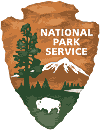Earth Science Week Classroom Activities
Making a Cave

Activity Source:
National Park Service. Developed by Kristen Lucke for the Views of the National Parks. Adapted with permission.
Background
We usually think of caves forming as rocks are dissolved and the particles are washed away, leaving hollow spaces behind. This activity simulates the way that dissolution, a chemical weathering process, leads to the formation of caves.
When precipitation such as rainwater or snowmelt mixes with carbon dioxide from the air and from decaying plants in the soil, the result is carbonic acid. This acidic water flows through cracks in the earth’s surface and seeps into the rocks below. Once the acidic water reaches carbonate rocks and other rocks that dissolve readily, it dissolves away the rock to create passageways, rooms, and speleothems — cave formations.
Materials
Per student or small group:
- 4 ounces of modeling clay
- Sugar cubes (3-6 per cave)
- See-through bowl (cutting the top off a 2-liter bottle works well)
- Toothpick
- Spray bottle with warm water
- Lined paper
- Pen or pencil
Procedure
- Organize the sugar cubes into a half pyramid along the bottom of the bowl, making sure the sugar is pressed up against on side of the bowl.
- Seal the cubes tightly with the modeling clay, making sure there are no gaps. The clay layer should be about 1/8 inch deep. The sugar cubes that are pressed up against the glass should remain visible. This will act as a window into your cave.
- Poke holes through the top of the clay with the tooth pick, making sure that the holes go all the way through to the sugar cubes and are large enough for water to flow through them.
- Spray the top of the cave with the warm water from the spray bottle. Continue spraying until the sugar cubes either are no longer in their original shape or have completely dissolved.
- As the water seeps through the clay and into the sugar cubes, record your observations.
- Draw a picture or describe what your cave looked like when finished.
- Discuss: What did the sugar cubes represent? What did the clay represent? Describe in your own words how this activity simulated the formation of caves.
See the full version of this summarized lesson plan.
